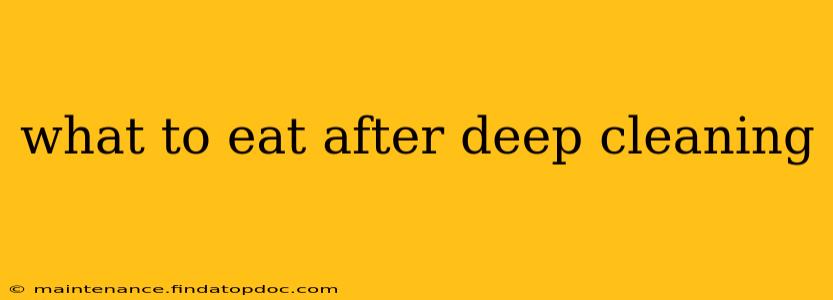A deep cleaning, also known as scaling and root planing, is a crucial procedure for maintaining optimal oral health. While it effectively removes plaque and tartar buildup below the gum line, it can leave your mouth feeling sensitive and sore. What you eat in the following days plays a significant role in your recovery and comfort. This guide will provide helpful tips and answer frequently asked questions about what to eat after a deep cleaning.
What should I eat after a deep cleaning?
The first 24 hours after your deep cleaning are the most crucial. Your gums will likely be tender and inflamed. Focus on consuming soft, cool foods that require minimal chewing. Excellent choices include:
- Yogurt: A protein-packed, cooling option that's gentle on your gums.
- Applesauce: Smooth and easy to swallow, applesauce provides essential nutrients.
- Mashed potatoes: A comforting and nutrient-rich choice, especially if you add a bit of broth for extra hydration.
- Scrambled eggs: A source of protein, easily digestible and soft.
- Oatmeal (without nuts or seeds): A soothing and filling option, particularly if it's prepared without any hard or crunchy additions.
- Smoothies: Blend fruits, vegetables, and yogurt for a nutritious and refreshing meal replacement.
What should I avoid eating after a deep cleaning?
For at least the first 24-48 hours, avoid foods that could irritate your gums or require extensive chewing. These include:
- Anything crunchy or hard: Chips, nuts, popcorn, crackers, etc. These can cause pain and potentially damage your healing gums.
- Spicy foods: These can further irritate already sensitive tissues.
- Acidic foods: Citrus fruits, tomatoes, and vinegar-based dressings can aggravate your gums.
- Extremely hot foods: Hot foods can increase discomfort and inflammation.
- Alcohol and caffeine: These can dehydrate you and potentially impact healing.
How long does it take to recover from a deep cleaning?
Recovery time varies, but most people experience significant improvement within a few days. However, complete healing might take a week or longer, depending on the severity of your periodontal disease. It's crucial to listen to your body and adjust your diet accordingly.
Can I eat solid foods after a deep cleaning?
Once the initial 24-48 hours have passed, and you're feeling less pain and discomfort, you can gradually reintroduce softer solid foods into your diet. Start with well-cooked vegetables and gradually incorporate other foods as tolerated. Always chew slowly and gently.
What are the best foods to promote healing after a deep cleaning?
Foods rich in Vitamin C and protein are vital for gum healing. Good sources include:
- Fruits and vegetables: Strawberries, oranges, broccoli, spinach, and bell peppers are excellent choices. (Ensure they're soft or pureed in the initial stages)
- Lean protein: Chicken, fish, and beans are great for promoting tissue repair.
Is it okay to eat ice cream after a deep cleaning?
While ice cream can provide temporary relief from discomfort due to its cooling effect, it's best to limit your intake. Excessive sugar can negatively impact oral health. If you choose to have ice cream, opt for a low-sugar variety.
What if I experience pain after a deep cleaning?
Contact your dentist or periodontist immediately if you experience severe or persistent pain, swelling, or bleeding after your deep cleaning. They can provide guidance on pain management and address any concerns. Following their post-operative instructions carefully is crucial for a successful recovery.
Remember, this information is for general guidance only. Always follow your dentist's specific post-operative instructions. Maintaining a healthy diet and diligent oral hygiene after a deep cleaning are vital for preventing future periodontal problems. Following these simple dietary guidelines can make your recovery much more comfortable and contribute to the long-term health of your gums and teeth.
